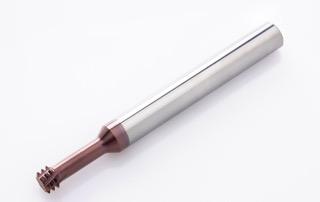
Designed for faster, more accurate thread milling in hard and heat-resistant materials, the new FSH Solid Carbide Thread Mills from Carmex Precision Tools are constructed of a specially formulated carbide that is triple-coated and carry from 5 to 7 flutes, depending on size.
The left-handed helix configuration results in a faster, smoother, and more accurate cut thanks to reduced deflection. The FSH series, which extends from 0.45 to 1.25 mm pitch, can be used in both conventional machining and Swiss- style applications.
Jim White, National Sales Manager for Carmex USA, states, “The FSH combines the latest in substrate and coatings with multiple flutes and the highly effective left-hand helix design to achieve both better performance and longer tool life in today’s hard-to-machine materials. Manufacturers who have previously attempted to use taps in small-hole threading understand that, especially in heat- resistant materials, breakage is a frequent occurrence. Given the value of the workpiece in terms of both material and operations previously invested, this can result in very expensive scrappage. Carmex engineering has developed the FSH to answer the challenges facing both manufacturers and shops, especially in aerospace, medical parts, and other cutting-edge industries.”
Contact Details
Related Glossary Terms
- flutes
flutes
Grooves and spaces in the body of a tool that permit chip removal from, and cutting-fluid application to, the point of cut.
- gang cutting ( milling)
gang cutting ( milling)
Machining with several cutters mounted on a single arbor, generally for simultaneous cutting.
- milling
milling
Machining operation in which metal or other material is removed by applying power to a rotating cutter. In vertical milling, the cutting tool is mounted vertically on the spindle. In horizontal milling, the cutting tool is mounted horizontally, either directly on the spindle or on an arbor. Horizontal milling is further broken down into conventional milling, where the cutter rotates opposite the direction of feed, or “up” into the workpiece; and climb milling, where the cutter rotates in the direction of feed, or “down” into the workpiece. Milling operations include plane or surface milling, endmilling, facemilling, angle milling, form milling and profiling.
- pitch
pitch
1. On a saw blade, the number of teeth per inch. 2. In threading, the number of threads per inch.
- threading
threading
Process of both external (e.g., thread milling) and internal (e.g., tapping, thread milling) cutting, turning and rolling of threads into particular material. Standardized specifications are available to determine the desired results of the threading process. Numerous thread-series designations are written for specific applications. Threading often is performed on a lathe. Specifications such as thread height are critical in determining the strength of the threads. The material used is taken into consideration in determining the expected results of any particular application for that threaded piece. In external threading, a calculated depth is required as well as a particular angle to the cut. To perform internal threading, the exact diameter to bore the hole is critical before threading. The threads are distinguished from one another by the amount of tolerance and/or allowance that is specified. See turning.
